When starting an article about Lake Ohrid, one can’t help but use such commonplace and even screaming epithets as the “the jewel of the Balkan Peninsula” and so on.
Lake Ohrid (Ohridsko Jezero – Macedonian name, Liqeni i Ohrit – Albanian name) is the deepest lake of the Balkan Peninsula with a maximum depth of 288 meters. The average depth is 155 meters. The lake is located on the border between the southwestern part of North Macedonia and the eastern part of Albania in a deep and blind valley. The lake is protected by the Galičica mountain range (2,288 meters) in the east, and by the Jablanica mountain range (2,257 meters) in the west.

(Lake Ohrid. Photo by © adriaticnature)
The lake is considered to be one of the oldest in Europe. Its history dates back to the Pliocene epoch of the Neocene period, which started on the planet more than five million years ago. The geological age of the lake is estimated at about 2-3 million years. It covers an area of 358.2 km. It is 30.8 km long. The maximum width is 14.8 km.
The lake is located at a height of 695 meters above sea level. Three relatively large settlements are situated on its shores, including the cities of Ohrid and Struga on the side of North Macedonia, and the city of Pogradec on the side of Albania, which have a very rich history.

(The city of Ohrid. Photo by © adriaticnature)
The lake is mostly supplied with water from underground sources, located along its eastern and southern shores. About a quarter of the water comes from 40 rivers flowing into the lake and precipitation, and the rest comes through karst tunnels from Lake Prespa, located ten kilometers southeastward, the water edge of which is 150 meters above the water edge of Lake Ohrid.
The water leaves the lake through natural evaporation and the only river that flows out (the Black Drin, which flows northward to Albania, where it merges with the White Drin, forming together the Drin River, which, in turn, flows into the Adriatic Sea, forming two arms). The northern arm, which is wide and short (about 15 kilometers long), is called the Great Drin. Near the Albanian city of Shkoder, it flows into the Bojana (Buna) River, which flows out of Lake Skadar and flows into the Adriatic Sea on the border between Albania and Montenegro. The other (southern) arm flows into the Gulf of Drin of the Adriatic Sea in the vicinity of the Albanian town of Lezhe.
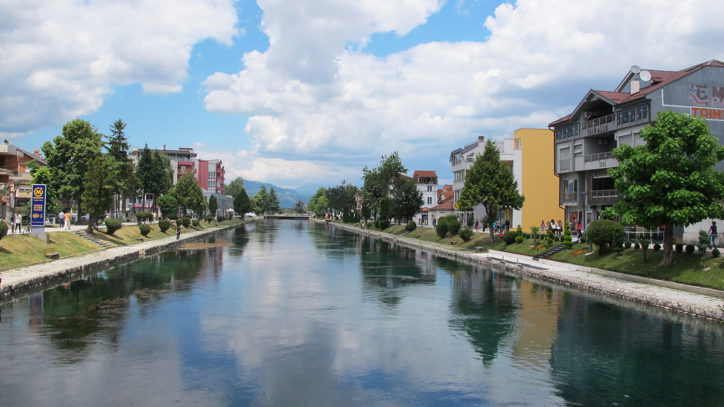
(The Black Drin River in its upper reaches. The city of Struga. Photo by © adriaticnature)
Currents are formed on the surface of Lake Ohrid, the water mainly moves counterclockwise along the shores.
The water temperature in the deep layers of Lake Ohrid is approximately 6 ° C, the water can warm up to 24 ° C on the surface, and up to 26 ° C in the near-shore zone. The water transparency is about 20 meters.
The most ancient settlements discovered in the course of archaeological studies on the shores of Lake Ohrid date back to the Neolithic Age, that is, about 6000 years BC.
In 1980, Lake Ohrid and the city of Ohrid were declared World Heritage Sites under the aegis of UNESCO.
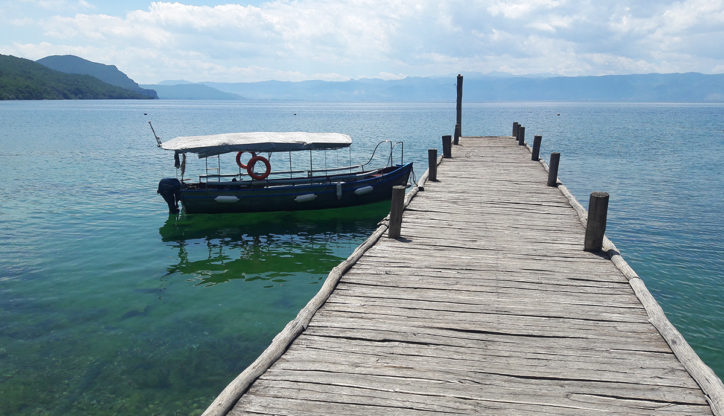
(Lake Ohrid. Photo by © adriaticnature)
The water body has preserved about 200 endemic species, most of which are algae, crustaceans, mollusks and worms. adriaticnature will dwell on the representatives of ichthyofauna, which are both unique, inhabiting only Lake Ohrid, and other fish species, inhabiting its clear waters, amounting to about 25.
Two endemic species of the Salmonidae family, Ohrid trout (Salmo letnica) and Belvica trout (Salmo ohridanus), are the “trademarks” of the lake. However, even the locals are often not very well aware of three endemic species of the Salmonidae family that inhabit Lake Ohrid. These are summer trout (Salmo aphelios), Struga trout, or kresnica (Salmo balcanicus) and Salmo lumi. And this can be explained.
(Ohrid trout. Video by © Ljupco Lepi)
Ohrid trout and Belvica trout are two completely independent species from the Salmonidae family.
Belvica trout is a relatively small fish that can be up to 34 centimeters long. In summer, it preys on insects, zooplankton and small fish near the surface and at depths of up to 20 meters, in winter it moves down to 25-50 meters.
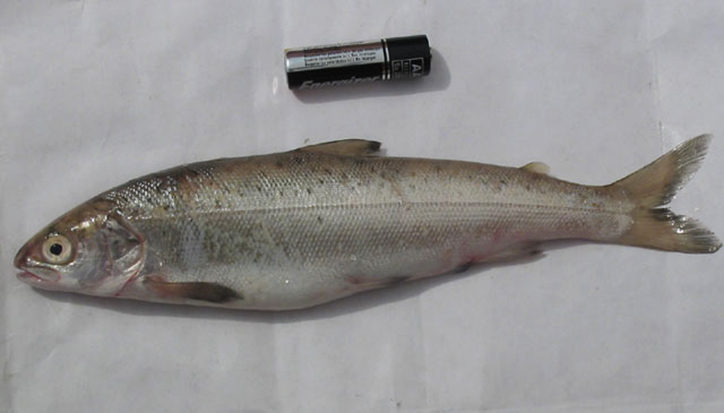
(Belvica trout. Photo by © Dragisa Mircevski. fishbase.org)
Ohrid trout (if we consider it the main representative of this species that is different from Belvica trout) has four intralacustrine forms. And although the differences between these forms are not completely proven at the morphological and molecular level, different breeding areas and time speak well for the fact that these fish are reproductively isolated from each other.
Ohrid trout, which can be up to 76 centimeters long and weigh 6.5 kilograms, spawns near the eastern and western shores of the lake in the areas with a rocky and sandy bottom from January to March.
Summer trout, which can be up to 40 centimeters long, spawns near the southeastern shore of the lake in the areas with a rocky bottom from July to August.
Struga trout, or kresnica, which can be up to 40 centimeters long, spawns near the northern and southern shores of the lake, as well as along the upper reaches of the Black Drin River, on the sections of the bottom with fine sand from December to January.
Salmo lumi, which can be up to 38 centimeters long, spawns in the rivers flowing into the lake from November to January.
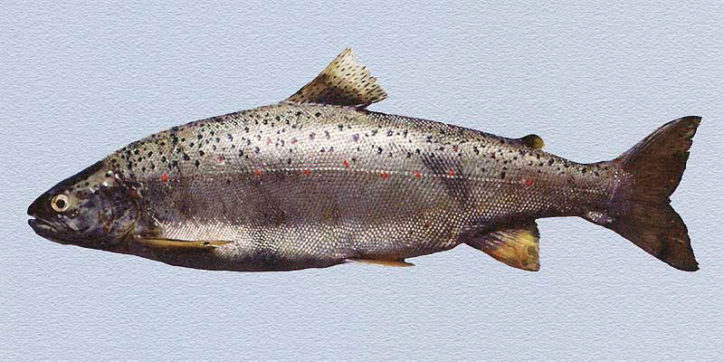
(Ohrid trout. Photo by © M. Kottelat, J. Freyhof. ittiofauna.org)
By the late 1990s and early 2000s, trout overfishing in Lake Ohrid threatened all species with extinction. In 2004, the government of Macedonia imposed a ten-year ban (until 2014) on trout fishing, and the government of Albania imposed a ban on trout fishing during spawning.
The Ohrid Hydrobiological Institute (JНУ Хидробиолошки Институт) supports the population of endemic trout species, releases up to 2.5 million trout juveniles into the lake annually, monitors the situation and develops a fishing strategy on Lake Ohrid.
(Release of juvenile trout into Lake Ohrid. Video by © Ljupco Lepi)
In addition to endemic species, rainbow trout was also released into the lake. It has done well and pleased anglers with its impressive size.
Since the trout of Lake Ohrid often prefers to swim far from the shore and rather deep, local fishermen usually use trolling with spinners, spoon lures or streamers.
Chub, carp and eel are among the most popular fishing targets on Lake Ohrid beside trout. Despite the presence of Barbus rebeli (crna mrena in Macedonian), endemic of Lake Ohrid, bleak, rudd, roach and other fishes, inhabiting the water body, the size matters in fishing.
(Schools of fish in Lake Ohrid. Video by © Ljupco Lepi)
Behavior and lifestyle of carp and eel in most water bodies are quite similar. Lake Ohrid is no exception. One thing should be mentioned: if you don’t follow the catch-and-release rule, your catch in such a clean flow-through lake will be extremely delicious. The same is in case of the Ohrid chub (ichthyologists keep on trying to make it a separate species persistently, and not without reason).
The chub in Lake Ohrid, as in other water bodies, prefers plugs of the so-called “crankbait” or simply “crank” type, derived from the English name of the bait. Small plugs with a large “head” and a thin short “tail” are one of the best spinning lures for the Ohrid predator, specimens of which often weigh more than two kilograms.
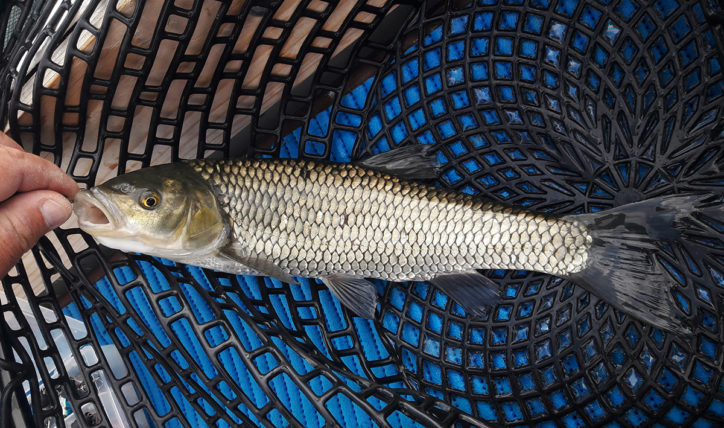
(Chub of Lake Ohrid. Photo by © adriaticnature)
If you are going to fish on Lake Ohrid on the Macedonian side, you should know some rules. As of 2019, they are as follows:
Minimum size of fish, which is allowed to be caught:
Ohrid trout (Salmo letnica) and its forms: 35 cm.
Belvica trout (Salmo ohridanus): 22 cm.
Common carp (Cyprinus carpio): 40 cm.
Alburnus scoranza: 12 cm.
European eel (Anguilla anguilla): 60 cm.
Chub (Squalius cephalus): 30 cm.
Common nase (Chondrostoma nasus): 25 cm.
Scardinius knezevici: 20 cm.
Western Balkan barbel (Barbus rebeli): 20 cm.
Albanian roach (Pachychilon pictum): 10 cm.
Ohrid gudgeon (Gobio ohridanus): 8 cm.
Fishing of the following fishes is allowed:
Ohrid trout (Salmo letnica) and its forms: from April 1 to October 31.
Belvica trout (Salmo ohridanus): from April 1 to December 19.
Common carp (Cyprinus carpio): from June 20 to May 19.
Chub (Squalius cephalus): from 1 June to 30 April.
Common nase (Chondrostoma nasus): from May 16 to April 14.
Scardinius knezevici: from June 1 to April 30.
It is forbidden to catch the following fishes:
Western Balkan barbel (Barbus rebeli): from May 20 to June 19.
Albanian roach (Pachychilon pictum): from May 20 to June 19.
There are the following daily catch limits:
Ohrid trout (Salmo letnica) and its forms: maximum 2 fish.
Belvica trout (Salmo ohridanus): maximum 10 fish.
Common carp (Cyprinus carpio): maximum 2 fish.
European eel (Anguilla anguilla): maximum 2 fish.
Chub (Squalius cephalus): maximum 15 fish.
Common nase (Chondrostoma nasus): maximum 15 fish.
Scardinius knezevici: maximum 20 fish.
Western Balkan barbel (Barbus rebeli): maximum 25 fish.
The maximum weight of the total daily catch of endemic trout should not exceed 3 kilograms. The maximum weight of the total daily catch should not exceed 5 kilograms. If the weight of the caught carp exceeds 5 kilograms, then in this case catching of two carps is allowed, without any weight limit. Prussian carp and rainbow trout are allowed to be caught in unlimited amounts.
The cost of a fishing license:
For a day – 200 Macedonian dinars;
for 7 days – 400 Macedonian dinars;
for 15 days – 500 Macedonian dinars;
for a year – 1,300 Macedonian dinars.
Penalties for fishing without a license can reach up to 500 euros.
One can obtain a license for fishing on Lake Ohrid at the Sveti Apostol Petar Fishing Sports Club, Ohrid, Dimitar Vlakhov St., House 48.
Fishes of Lake Ohrid:
– Belvica trout (Salmo ohridanus). Belvica (Macedonian), Belushka (Albanian).
– Ohrid trout (Salmo letnica). Ohridska pastrmka, letnica (Macedonian), Korani (Albanian).
– Summer trout (Salmo aphelios). Letna pastrmka (Macedonian), Korani i verës (Albanian).
– Struga trout, or kresnica (Salmo balcanicus). Balkanska ili strushka pastrmka (Macedonian), Korani ballkanik (Albanian).
– Salmo lumi. Korani i lumit (Albanian).
– Rainbow trout (Oncorhynchus mykiss). Kaliforniska ili vinozhitna pastrmka (Macedonian), Trofta e ylbertë (Albanian).
– Ohrid spirlin (Alburnoides ohridanus). Vardarka (Macedonian), Barkgjëra e Ohrit (Albanian).
– Alburnus scoranza. Belvica, or plashica (Macedonian), Gjuca (Albanian).
– Western Balkan barbel (Barbus rebeli). Crna mrena (Macedonian), Mrena e Fanit (Albanian).
– Common carp (Cyprinus carpio). Krap (Macedonian), Krapi (Albanian).
– Prussian carp (Carassius gibelio). Srebren karas (Macedonian), Karasi prusian (Albanian).
– Common nase (Chondrostoma nasus). Skobust (Macedonian), Njila (Albanian).
– Ohrid gudgeon (Gobio ohridanus). Krkusha, or dujak (Macedonian), Mrena e Ohrit (Albanian).
– Silver carp (Hypophthalmichthys molitrix). Tolstolobik (Macedonian), Ballëgjeri i bardhë (Albanian).
– Dalmatian roach (Leucos basak). Grunec (Macedonian), Skorta e Ohrit (Albanian).
– Albanian roach (Pachychilon pictum). Moranec (Macedonian), Skorta e zezë (Albanian).
– Eurasian minnow (Phoxinus phoxinus). Pior (Macedonian), Cigani italian (Albanian).
– Ohrid minnow (Pelasgus minutus). Grunche (Macedonian), Grunci i vogël (Albanian).
– Stone moroko (Pseudorasbora parva). Amurche (Macedonian), Notaku (Albanian).
– European bitterling (Rhodeus amarus). Platiche, or ploska (Macedonian), Idhtaku (Albanian).
– Scardinius knezevici. Pisa (Macedonian), Lloska (Albanian).
– Chub, or European chub (Squalius cephalus). Klen (Macedonian), Mëlyshi (Albanian).
– Ohrid spined loach (Cobitis ohridana). Ohridska shtipalka (Macedonian), Mrena e egër e Ohrit (Albanian).
– Ohrid stone loach (Barbatula sturanyi). Vretenushka (Macedonian), Tufëza e Ohrit (Albanian).
– European eel (Anguilla anguilla). Jagula (Macedonian), Ngjala (Albanian).
– Pumpkinseed (Lepomis gibbosus). Sonchanica, or soncharka (Macedonian), Sharoku diellor (Albanian).